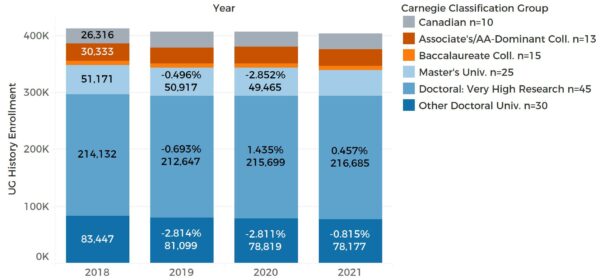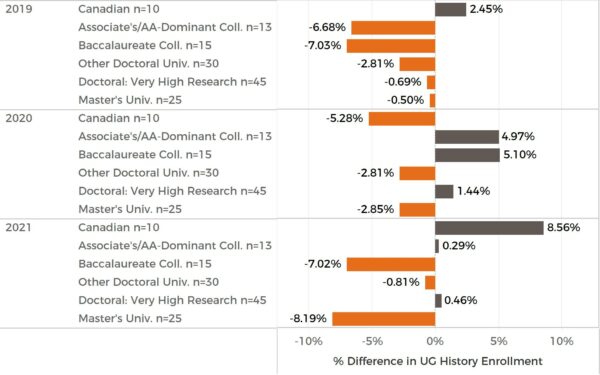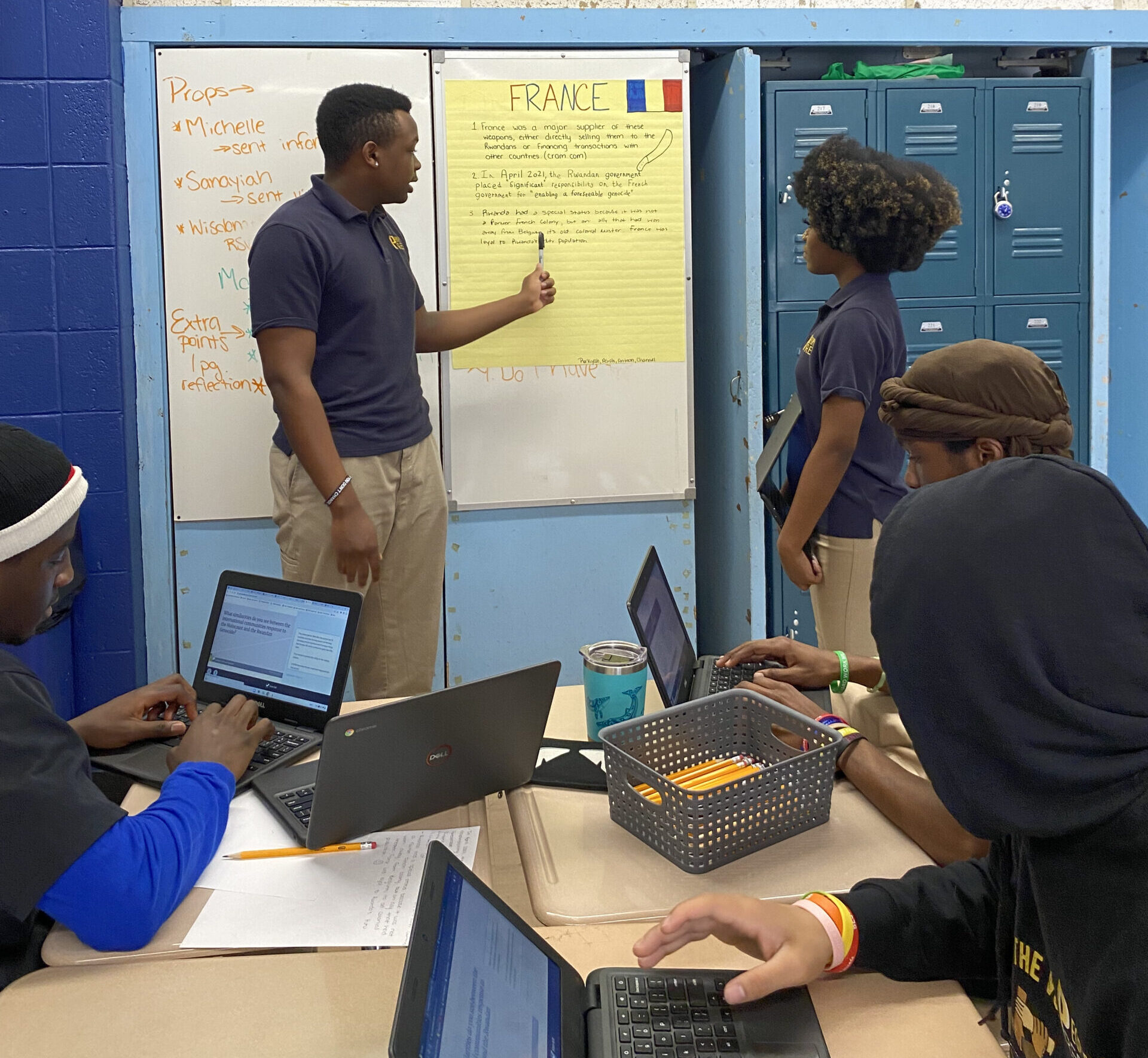
While undergraduate student enrollments decline across US universities, history enrollments have not suffered particular damage from the pandemic. Museums Victoria/Unsplash
The results from the AHA’s 2021 History Enrollment Survey show academic units and history students managing the upheavals of the COVID-19 pandemic as best they can. Both in the quantitative data and in comments from respondents, the sense in many history departments seemed to be that, as bad as the pandemic has been in countless ways, it has not been as bad as they feared for student enrollment in history courses. Over the past four academic years, the number of undergraduate history enrollments at responding institutions has fallen by 2 percent. This is more than the 1.3 percent decline over four years that we found last year, but not a catastrophic drop.
In response to the survey, 138 colleges and universities in the United States and Canada provided full data for the past four academic years: 2017–18, 2018–19, 2019–20, and 2020–21. This is an increase of 24 institutions over participation in last year’s survey, and their responses reflect immediate changes in student enrollment as a result of COVID-19. In total, the responses represent 412,613 student enrollments in 2017–18 and 404,351 in 2020–21.
History declines have been smaller than overall college enrollment declines.
Because of the types of institutions that responded, the results for higher education in general should be interpreted with caution. This year’s responses skew toward larger research institutions—including 49 US universities in the “very high research” Carnegie classification. While a concerted effort for participation from two-year colleges yielded a better-than-usual 13 responses, the number of baccalaureate colleges fell from 23 last year to just 15 this year, making it difficult to draw conclusions about trends at that type of institution. This might speak to pandemic-induced staffing changes, and certainly to the difficulty many smaller departments and units had in accessing the necessary quantitative information remotely and ensuring someone submitted the survey, particularly as transitions back to in-person learning were underway from June to September.
Over the four years of reported enrollments, the 10 Canadian universities saw a 5.3 percent increase in undergraduate enrollment, the 87 public US institutions saw a 2.1 percent decrease, and the 41 private US institutions saw a 4.9 percent decline. As usual, the overrepresentation of the highest-research doctoral universities and their large sizes tend to blunt larger percentage swings at smaller colleges and universities (Fig. 1).

Fig. 1: Undergraduate history enrollment by institution type (n = 138).
In aggregate, history declines have been smaller than overall college enrollment declines. According to National Student Clearinghouse data reported in the Chronicle of Higher Education, overall enrollment of undergraduate students in the United States declined 3.4 percent between fall 2019 and fall 2020 and then another 3.5 percent in fall 2021. The AHA’s survey data does not reflect a decline of that magnitude, a discrepancy due in part to the type of institutions that responded to our survey. Nationwide, single-year declines were especially big at two-year colleges (down 9.4 percent and then another 6 percent) as opposed to the relatively small drops at four-year nonprofit institutions. The dominance of four-year respondents in our survey means we have fewer respondents from the institutions where overall enrollment fell most precipitously because of the pandemic (Fig. 2).

Fig. 2: Change from previous year by institution type (US) or country.
As usual, there is tremendous variation in the enrollment changes from one college to the next. However, it is interesting that in the most recent year, 67 respondents reported a positive annual change in their undergraduate history enrollments, whereas in the two previous years, only 55 or 56 saw any increase. This small sign of growth supports the idea that history enrollments have not suffered particular damage from the pandemic. Indeed, the changes that many history instructors have made to their courses, as well as the hard-won ability to offer courses in several modalities (in person, hybrid, synchronous online, asynchronous online), may prove to be valuable adaptations. As one respondent put it, “Aspects of our program benefitted dramatically from the shift to online because of the pandemic. In particular, our summer enrollments more than doubled. For that reason, we are pursuing a path of largely online sync/asynch courses for our spring/summer semester from now on.” Another respondent agreed that “online courses enrolled quite well during the pandemic” but added that “almost everyone is happy to be back in person in fall 2021.”
Why are total changes relatively small? Some of the more positive news may indicate cautious decision-making by students. When choosing which courses to take under unstable, pandemic conditions, an emergency-remote or hybrid history course might have seemed a lower-stakes option—with less potential risk to students’ overall college plans—than a lab course in biology, or psychology and business courses with team projects.
As students tried to continue their education in 2020–21 by taking classes in whatever formats made sense, history departments and joint academic units scrambled to offer the courses they could with the faculty they had. As one respondent described it, “Due to a hiring freeze, retirements, and one year suspension of grad admissions, we have been limited in providing seats. Our major numbers have been on an incremental increase, however. We, like all, have been challenged by COVID and haven’t been able to focus on growth, nor do we have the staffing.”
The changes that many history instructors have made to their courses may prove to be valuable adaptations.
Staffing and space constraints varied among institutions; historians and their administrative colleagues made decisions about teaching modality and enrollment caps that made the most sense for their students, fellow faculty, and particular campuses. For many academic units, the pandemic enrollment story has been about managing greater uncertainty with fewer resources (human and financial) in an ongoing attempt to match the supply of spaces in online, hybrid, and in-person history courses with shrinking budgets and unpredictable demand from students. Some departments took steps to limit class size (whether in person or online) because of the pandemic. Others suspended admissions to their history graduate program, decreasing the supply of potential teaching assistants. Undergraduate enrollment caps were lowered for that reason.
“Our enrollments are strong and have been rising,” wrote one respondent. “We might, however, have to limit class size because of a reduction in the number of graduate students admitted to the program. We will not have the requisite number of TAs for large classes.” Another explained, “Our program size (majors, enrollments) has remained fairly stable during the pandemic, despite most courses having been moved to hybrid or fully online formats. While multiple visiting faculty were let go, continuing faculty saw their teaching load increase. The number of course offerings has been somewhat reduced, but the fill rates have increased significantly.”
History departments and joint academic units scrambled to offer the courses they could with the faculty they had.
With so many short- and long-term changes to higher education prompted by the pandemic, an additional source of optimism for some respondents was a renewal of conviction that history educators have something essential to contribute to society. “People have a thirst for understanding history and society, especially American history, in the light of all that’s happened and history departments around the country should assert themselves within their institutions,” one respondent wrote. The AHA has made resources available for precisely this purpose, from the Department Advocacy Toolkit to A Bibliography of Historians’ Responses to COVID-19 and Remote Teaching Resources.
While the process has been painful, history faculty members are dedicated to teaching students however they can. Some students and potential students may be out of reach for the time being, but hope endures that the difficulties of the past two years—and all that the community of historians has learned from them—will serve as the foundation for resilience and renewal in the future.
This work is licensed under a Creative Commons Attribution-NonCommercial-NoDerivatives 4.0 International License. Attribution must provide author name, article title, Perspectives on History, date of publication, and a link to this page. This license applies only to the article, not to text or images used here by permission.



